Cycle Intervals and Start Date Examples
It's important to understand the modeling of a cycle of intervals, no cycle of intervals, as their relationship to the start date for an Asset. The start date is key to controlling when the forecast will begin. This could be in the past, present, or future.
Example 1: Maintenance is due on the 1st of every month and does not have a cycle of intervals. Maintenance was last accomplished for the Asset on 1-Jun (before starting this new program) and is next due on 1-July. In this example, the first due will begin on the start date and not from a historical last completed maintenance date.
- Setting a start date of 23-Jun, before the 1st of the next month, means the first/next due is 1-July and is then due every month from that point forward.

Example 2: Maintenance is due on the 1st of every month on a cycle of 12 intervals. This is the same as Example 1, it just uses a repeating interval, and the work definitions are due at each interval. Maintenance was last accomplished for the Asset on 1-Jun (before starting this new program) and is next due on 1-July. In this example, the Intervals will begin on the start date and not from a historical last completed maintenance date and interval.
- Setting a start date of 23-Jun, before the 1st of the next month, along with a monthly repeating pattern means the first/next due is 1-July and is then due every month from that point forward.

Example 3: Same as Example 2 but set the start date = First Due date and Interval.
- Setting a start date of 1-July along with a monthly repeating pattern means the first/next due is 1-July at Interval 1 and is then due every month from that point forward. This is the same behavior as example 2.

Example 4: Maintenance is due on the 1st of every month on a cycle of 12 intervals. This is like Example 3 however it has 2 work definitions due at different intervals. When they overlap, the rule is to Suppress the lower interval work definition. Maintenance was last accomplished for the Asset on 1-Jun (before starting this new program) and is next due on 1-July. In this example, the Intervals will begin on the start date and not from a historical last completed maintenance date and interval.
- Setting a start date of 23-Jun, before the 1st of the next month, along with a monthly repeating pattern means the first/next due is 1-July and is then due every month from that point forward.
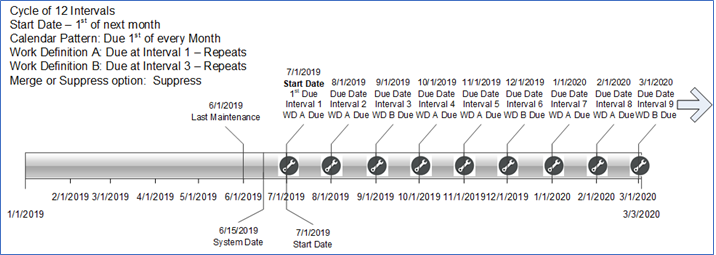
Example 5: This is also like example 4; however, it has 2 work definitions due at different intervals. When they overlap, the rule is to Merge all work definitions. Maintenance was last accomplished for the Asset on 1-Jun (before starting this new program) and is next due on 1-July. In this example, the Intervals will begin on the start date and not from a historical last completed maintenance date and interval.
- Setting a start date of 23-Jun, before the 1st of the next month, along with a monthly repeating pattern means the first/next due is 1-July and is then due every month from that point forward.
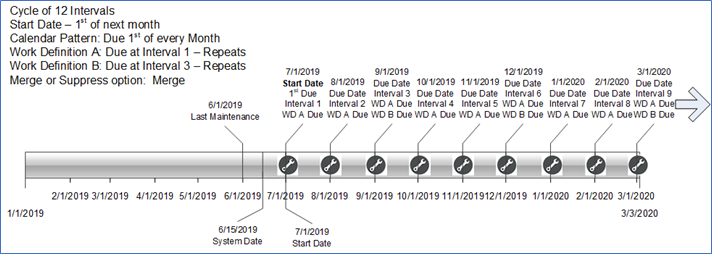
Example 6: Maintenance is due on some months, on the 1st, over a cycle of 12 intervals. When it is due, it could be one or the other work definition. When they overlap, the rule is to Suppress the lower interval work definition. Maintenance was last accomplished for the Asset on 1-Jun (before starting this new program) and is next due on 1-Sept at a future interval. In this example, the Intervals will begin on the start date and not from a historical last completed maintenance date and interval.
- Setting a start date of 23-Jun, before the 1st of the next month, along with a monthly repeating pattern means the first/next due is 1-Sept on Interval 3 and is then due every interval where a work definition falls due.
- Note that Intervals 1, 2, 5, 7, 10, and 11 are skipped. Interval 12 will have Work Definition B suppress A.
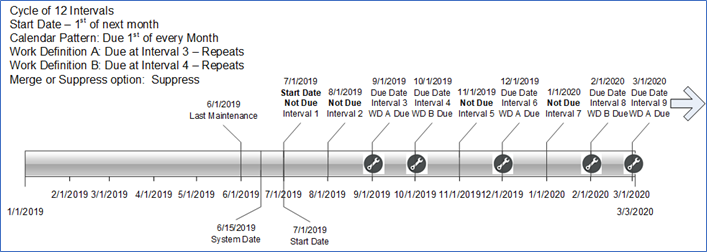
Example 7: Maintenance is due on the 1st of every month on a cycle of 12 intervals. Maintenance was last accomplished for the Asset on 1-Jun (before starting this new program). However, it is not required to be due again until 1-August. In this example, the Intervals will begin on the start date after 1-Jul and not from a historical last completed maintenance date and interval. Therefore, a due date in the future on 1-July is being skipped.
- Setting a start date after 1-July, but before 1-Aug, along with a monthly repeating pattern means the first/next due is 1-Aug and is then due every month from that point forward. 1-July will be skipped by design.

Example 8: Same as Example 3 but set the start date = First Due date and Interval.
- Therefore, setting a start date of 1-Aug and monthly repeating pattern means the first/next due is 1-Aug and is then due every month from that point forward. 1-July will be skipped by design. This is the same behavior as example 7.

Example 9: Maintenance is due on the 1st of every 3 months on a cycle of 12 intervals. Maintenance was last accomplished for the Asset on 1-Jun (before starting this new program) and is due again on 1-Sept. In this example, the Intervals will begin on the start date and not from a historical last completed maintenance date and interval.
- The Start date should be set after the start date, but before or on 1-Jul is when Interval 1 begins calculating. The system will then skip intervals 1 and 2, with the first due at Interval 3 on 1-Sept.
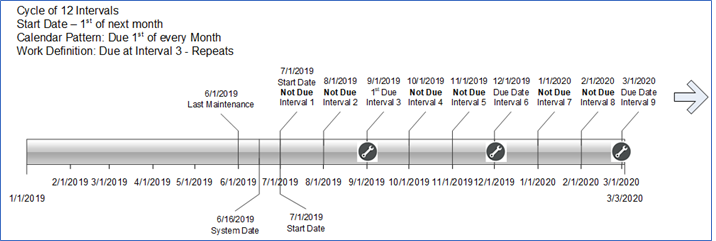
Example 10: Maintenance is due on the 1st of only certain months on a cycle of 12 intervals. It will be due at intervals 1,4,7, and 10. Maintenance was last accomplished for the Asset on 1-Jun (before starting this new program) and is next due on 1-Sept at Interval 1. This example, the Intervals will begin on the start date and not from a historical last completed maintenance date and interval.
- The Start date should be set so that 1-Sept is when Interval 1 begins calculating. Therefore, the start date can be on or between the system date and first due date of 1-Sept.
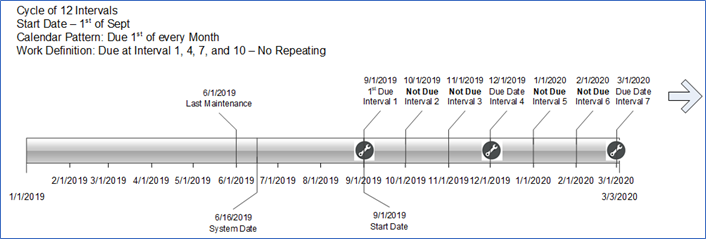
Example 11: Maintenance is due on the 1st of every month on a cycle of 12 intervals. Maintenance was last accomplished for the Asset on 1-Jun (before starting this new program) at Interval # 6. Therefore, it is next due at a specific interval # 7 on 1-Jul. This example does not use the historical last completed maintenance date and interval, but just relies on a past dated start date to sequence the next due date and interval.
- The Start date should be set in the past to replicate the last completion at Interval 6 and initialize the forecast for the next to at Interval 7. Setting a start date of 1-Jan will allow an Asset to “cut in” its next due in the middle of a Cycle, since the first/next due will always be >= sysdate anyway. The Intervals can calculate in the past, but only the first due date will be in the future.
- Note that the cycle repeats on Jan-1-2020 and starts at Interval 1 again.
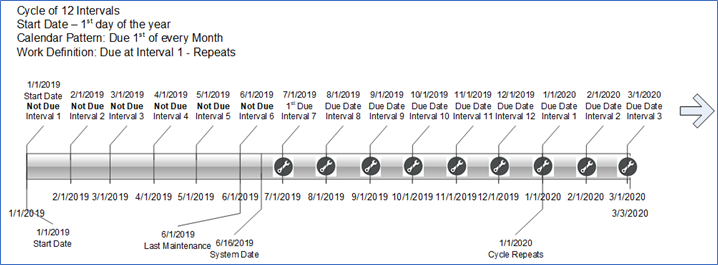
Example 12: Maintenance is due on the 1st of every month on a cycle of 12 intervals. Maintenance was last accomplished for the Asset on 1-Jun (before starting this new program) at Interval # 6. Therefore, it is next due at a specific interval # 7 on 1-Jul. In this example, the Intervals will begin on the historical last maintenance date and interval of 1-Apr and Interval 4, instead of back at the 1st of the year. This example will use of the historical last completed date and interval to reach the same outcome as Example 7. For an Item-based requirement, it allows for each asset to have its individual forecast initialized.
- Setting a start date of between or on sysdate and the first Interval 1 on 1-Jul, along with a monthly repeating pattern, means the first/next due is 1-July at Interval 7 and is then due every month from that point forward.
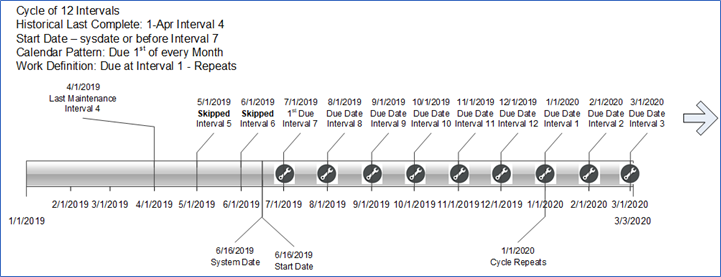
Day Interval Forecast Examples
A Day Interval, or Number of Days, forecast method will allow you additional flexibility than the calendar pattern. The calendar pattern is limited on the combinations and can be difficult to start a forecast and sequence intervals that don’t easily follow a calendar method. Examples are maintenance every 15 days, 90 days, etc.
The Day Interval method also features some capabilities found in the Meter-Based method, such as the ability to generate the next due date in the forecast based on the previous work order completion date. This will provide an optional for a dynamic forecast. Additionally, you can more easily initialize the first due for an asset based on the historical last accomplishment date using a day interval.
For examples, they will be the same as the meter-based, as the forecast will use the number of days as an interval value to increment the future due dates. The intervals will be calculated from the start date of the Work Requirement for the Asset, then incremented by the number of Days value.
Day Interval Examples:
Example 1: Maintenance is due every 15 days and does not have a cycle of intervals. Maintenance was last accomplished for the Asset on 1-Jun (before starting this new program) and is next due on 15-July, then every 15 days after.
- Setting a start date of 30-Jun, which will then calculate the first due =
15-Jul. The Day interval starts calculating on the next day after the start
date, then increments the 15 days. This is how Excel calculates dates.
- 1-Jul + 15 days = 16-Jul
- 30-Jun + 15 days = 15-Jul.

Example 2: Maintenance is due on certain intervals of a cycle of 12 intervals. The Day interval is 15 days and is due every 3 intervals (3,6,9,12). Maintenance was last accomplished for the Asset on 1-Jun (before starting this new program) and is next due on 15-Aug.
- Setting a start date of 30-Jun, which will then calculate the first interval = 15-Jul. The Day interval starts calculating on the next day after the start date, then increments the 15 days for each interval.
- Since it is due every 3 intervals, the first dues is 15-Aug at Interval 3.
